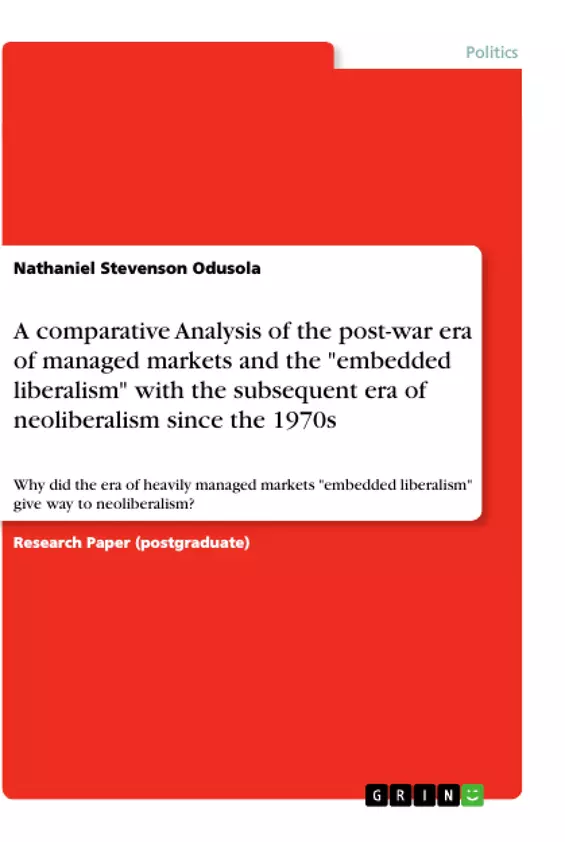This article made comparison between ‘embedded liberalism' and ‘neoliberalism'. The article also traced the basis for the shift from ‘embedded liberalism' to the emergence of ‘neoliberalism'. In order for the government to intervene in economic policies matters; democracy was the driving force for the spread of embedded liberalism. Macroeconomics was introduced by the government of advanced economies to address three critical areas of the economic policies, namely: inflation, market output, and unemployment.
The other aspect of this period was to win the cold war and to empower the United States as the global hegemon. The departure from embedded liberalism to neoliberalism in 1971 was due to domestic economic pressure of the US. President Nixon’s administration ended the ‘convertibility of the dollar into gold' policy regime. The government had to float the dollar in the international market allowing market forces to determine the value of the dollar currency.
The administration of Reagan and Thatcher institutionalised ‘neoliberalism' as an alternative to ‘embedded liberalism'. The adoption of ‘neoliberalism' led both administrations to implement monetary policies which led to stripping labour from further threatening the economies of the United States and the United Kingdom with inflation. The overall implications were increased profits for capitalists or entrepreneurs as against employees of the labour market. The analysis revealed that there was an increased unemployment rate due to high-interest rates and deliberate policies to encourage recession in order to forestall inflation.
Inhaltsverzeichnis (Table of Contents)
- INTRODUCTION
- COMPARISON BETWEEN EMBEDDED LIBERALISM AND NEOLIBERALISM
- Embedded Liberalism:
- Neoliberalism:
Zielsetzung und Themenschwerpunkte (Objectives and Key Themes)
This article provides a comparative analysis of "embedded liberalism" and "neoliberalism", examining the historical context, key features, and impact of each economic ideology. The article focuses on the transition from "embedded liberalism" to "neoliberalism" in the 1970s, exploring the factors that contributed to this shift.
- Comparison of "embedded liberalism" and "neoliberalism"
- The transition from "embedded liberalism" to "neoliberalism" in the 1970s
- The role of government intervention in the economy
- The impact of Keynesian macroeconomic theory
- The influence of globalization on economic policies
Zusammenfassung der Kapitel (Chapter Summaries)
- INTRODUCTION: This section provides a historical overview of "embedded liberalism" and "neoliberalism", highlighting the key features and context of each economic ideology. The period between World War II and the 1970s is identified as the era of "embedded liberalism", characterized by government intervention in economic regulation. The adoption of Keynesian macroeconomic theory, the role of government in creating social welfare programs, and the emergence of "embedded liberalism" as a constructivist approach to international relations are discussed.
- COMPARISON BETWEEN EMBEDDED LIBERALISM AND NEOLIBERALISM: This section delves into a detailed comparison of "embedded liberalism" and "neoliberalism", highlighting key differences in economic policies, government roles, and global economic impacts. It explores the Bretton Woods system, the impact of the Cold War on economic ideologies, and the rise of social democratic policies in the post-World War II era. This section also discusses the influence of Keynesian macroeconomic theory on domestic economies and the development of monetary and fiscal policies.
- Embedded Liberalism: This section focuses on the key features of "embedded liberalism", including controlled capital flow, liberal trade arrangements, and the Bretton Woods approach to global economic growth. It highlights the role of international organizations like the IMF and the World Bank in promoting economic stability and development. The impact of "embedded liberalism" on domestic economies, with particular emphasis on high employment rates and the creation of social safety nets, is discussed.
- Neoliberalism: This section explores the emergence of "neoliberalism" as an alternative to "embedded liberalism", highlighting its emphasis on market competition, deregulation, and limited government intervention. It analyzes the impact of neoliberal policies on labor markets, wage levels, and economic growth. The section also discusses the concept of "financialization" and its role in shaping the global financial landscape.
Schlüsselwörter (Keywords)
This article explores the fundamental concepts of "embedded liberalism" and "neoliberalism" in relation to economic policies, global governance, and the impact of government intervention. Key concepts include Keynesian macroeconomic theory, Bretton Woods system, social welfare programs, globalization, financialization, and the role of international organizations in shaping the global economic landscape.
- Arbeit zitieren
- Nathaniel Stevenson Odusola (Autor:in), 2019, A comparative Analysis of the post-war era of managed markets and the "embedded liberalism" with the subsequent era of neoliberalism since the 1970s, München, GRIN Verlag, https://www.grin.com/document/923223



